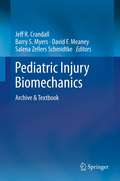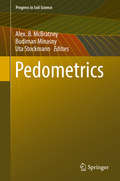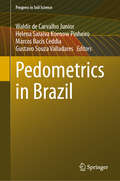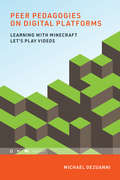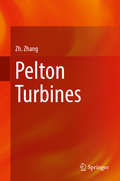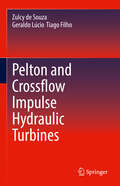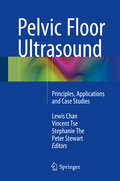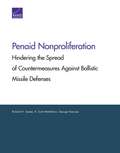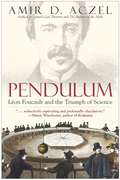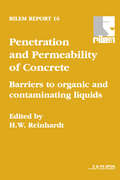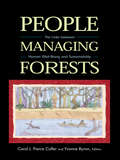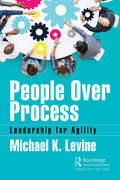- Table View
- List View
Pediatric Injury Biomechanics
by Barry S. Myers Jeff R. Crandall Salena Zellers Schmidtke David F. MeaneyPediatric Injury Biomechanics: Archive and Textbook consolidates and describes the current state of the art in pediatric injury biomechanics research in the automotive crash environment. Written by the most respected scientists in the field, the objective of this ground-breaking project is to provide a comprehensive archive and analysis of pediatric injury biomechanics research; to be the go-to reference for the epidemiology of motor vehicle related childhood injury data, pediatric anthropometry, pediatric biomechanical properties, tissue tolerance, and computational models. This book provides essential information needed by researchers working in the field of pediatric injury including those involved in rulemaking activities, injury criteria development, child dummy development, and child injury interventions development. In addition to the text, a companion archive will include valuable information and tools to assist in the identification of gaps in research and future research directions.This living document will be regularly updated with current research and advancements in pediatric injury biomechanics.
Pediatric Treatment of Sleep Apnea: With Teledontics/Telegnathics
by Joseph YousefianThis first of two volumes presents groundbreaking information on sleep apnea in children and youths. It provides easily comprehensible instruction ideal for students; practicing dental, medical, and allied medical practitioners; and researchers who wish to expand their knowledge base on this critical interdisciplinary topic. The book contains practical and well-documented case examples, which are not theoretical but illustrate common patient problems and effective, unparalleled interdisciplinary treatment strategies.There is a disconnect on how health professions perceive and treat the causes of upper airway conditions. Various comorbidities can result from sleep apnea, oxygen deprivation, and upper airway conditions. This book connects oropharyngeal structure to metabolic disease through the practice of teledontics. Teledontics as a new interdisciplinary integrative medical–dental approach for treatment of obstructive sleep apnea is emerging rapidly. It relates oxygen needs of the body in addition to other nutritional requirements, focusing on how oxygen insufficiency can lead to multiple health comorbidities.
Pedology in the USA: Life and Works of C. C. Nikiforoff (1886–1979) (Springer Biographies)
by Alfred E. HarteminkConstantin Nikiforoff was educated by premier Russian soil scientists but fled after the 1917 revolution. A refugee with no formal credentials or documentation, he arrived in the USA in 1921. He was hired in 1927 and started surveying and studying soils across the country. He was erudite, critical, and wrote several influential papers. In some ways, he was ahead of his time; in others, his ideas were later proven incorrect. Yet, in all respects, he was a distinctive researcher whose work left a lasting mark on the field of American soil science. This richly illustrated book explores the life and works of Constantin Nikiforoff against the backdrop of soil science advancements during the first half of the twentieth century.• Biography of the Russian American pedologist Constantin Nikiforoff• Chronicles his life, works, and influence on American soil science• Richly illustrated with a collection of unique photos• A fascinating read for anyone interested in the history of science
Pedometrics (Progress In Soil Science Ser.)
by Budiman Minasny Alex. B. McBratney Uta StockmannThis book presents the basic concepts of quantitative soil science and, within this framework, it seeks to construct a new body of knowledge. There is a growing need for quantitative approach in soil science, which arises from a general demand for improved economic production and environmental management. Pedometrics can be defined as the development and application of statistical and mathematical methods applicable to data analysis problems in soil science. This book shows how pedometrics can address key soil-related questions from a quantitative point of view. It addresses four main areas which are akin to the problems of conventional pedology: (i) Understanding the pattern of soil distribution in character space – soil classification, (ii) Understanding soil spatial and temporal variation, (iii) Evaluating the utility and quality of soil and ultimately, (iv) Understanding the genesis of soil. This is the first book that address these problems in a coherent quantitate approach.
Pedometrics in Brazil (Progress in Soil Science)
by Marcos Bacis Ceddia Waldir de Carvalho Junior Helena Saraiva Koenow Pinheiro Gustavo Souza ValladaresIn a world expected to reach a population of almost 10 billion inhabitants by 2050 and facing rapid global warming, it is essential to develop studies to better characterize and preserve the existing environmental heritage. Among these assets, soil stands out, which is fundamental for the balance of life on the planet (air quality and composition, temperature regulation, carbon and nutrient cycling, water cycling and quality, natural "waste" (decomposition) treatment and recycling, and habitat for most living things and their food). Due its importance, Soil information is increasing recently in order to attend human demands for land use management and capability, reduce erosion risks and soil security, for example. Particularly in Brazil, advances in soil science are now required to attend the new national systematic soil survey that have as a goal soil sustainability and security. Gathering machine learning tools, pedometrics and pedological concepts is a way to achieve these demands regarding soil data and related products. This book summarizes remarkable insights from the II Pedometrics Brazil Conference providing cutting-edge information to researchers, students and professionals working with soils in tropical countries such as Brazil.
Pedro Perfecto y la mansión misteriosa
by Andrea BeatyPedro Perfecto es un arquitecto en su esencia: cuando no está haciendo casas con comida, su cabeza está en las nubes, soñando con el diseño. Así que queda totalmente impresionado cuando la tía Bernice de Ada Twist hereda una vieja casa del magnate de los helados Herbert Sherbert que está llena de innumerables habitaciones de todos sus períodos arquitectónicos favoritos. Pero algo no anda bien. . . Todo el mundo dice que la casa está embrujada, y parece que varias antigüedades con un valor incalculable, que supuestamente ayudarían a la tía Bernice a pagar el mantenimiento de la casa, han desaparecido. Si no pueden encontrar esas antigüedades, la tía Bernice podría perder la casa para siempre. ¡Se necesitarán todos los conocimientos de arquitectura de Pedro y la ayuda de los otros interrogadores, Rosie Revere, Ada Twist y Sofia Valdez, para resolver el misterio y encontrar el tesoro!
Peeking at Peak Oil
by Michael Lardelli Olle Qvennerstedt Kjell AleklettThe term "Peak Oil" was born in January 2001 when Colin Campbell formed the Association for the Study of Peak Oil & Gas (ASPO). Now, Peak Oil is used thousands of times a day by journalists, politicians, industry leaders, economists, scientists and countless others around the globe. Peak Oil is not the end of oil but it tells us the end is in sight. Anyone interested in food production, economic growth, climate change or global security needs to understand this new reality. In Peeking at Peak Oil Professor Kjell Aleklett, President of ASPO International and head of the world's leading research group on Peak Oil, describes the decade-long journey of Peak Oil from extremist fringe theory to today's accepted fact: Global oil production is entering terminal decline. He explains everything you need to know about Peak Oil and its world-changing consequences from an insider's perspective. In simple steps, Kjell tells us how oil is formed, discovered and produced. He uses science to reveal the errors and deceit of national and international oil authorities, companies and governments too terrified to admit the truth. He describes his personal involvement in the intrigues of the past decade. What happens when a handful of giant oil fields containing two thirds of our planet's oil become depleted? Will major oil consumers such as the EU and US face rationing within a decade? Will oil producing nations conserve their own oil when they realize that no one can export oil to them in the future? Does Peak Oil mean Peak Economic Growth? If you want to know the real story about energy today and what the future has in store, then you need to be "Peeking at Peak Oil".
Peer Pedagogies on Digital Platforms: Learning with Minecraft Let's Play Videos (Learning in Large-Scale Environments)
by Michael DezuanniHow a popular entertainment genre on YouTube--Let's Play videos created by Minecraft players--offers opportunities for children to learn from their peers.Every day millions of children around the world watch video gameplay on YouTube in the form of a popular entertainment genre known as Let's Play videos. These videos, which present a player's gameplay and commentary, offer children opportunities for interaction and learning not available in traditional television viewing or solo video gameplay. In this book, Michael Dezuanni examines why Let's Play videos are so appealing to children, looking in particular at videos of Minecraft gameplay. He finds that a significant aspect of the popularity of these videos is the opportunity for knowledge and skill exchange.
Pegasus, the Heart of the Harrier: The History & Development of the World's First Operational Vertical Take-off & Landing Jet Engine
by Andrew DowThis volume chronicles the making of the Harrier Jump Jet—the innovative Cold War fighter aircraft designed to operate from virtually anywhere. In 1957, the British engine manufacturer Bristol Siddeley turned aircraft design on its head with the creation of the Pegasus engine. Until then, aircraft designs would seek out suitable engines. Now the Pegasus was an engine in search of a suitable aircraft. The result was the famous Hawker Siddeley Harrier, the first military airplane capable of vertical takeoff and landings. To this day, Harrier Jump Jets are still in front-line service with air forces around the world including the Royal Air Force and US Marine Corps. In this volume, former Bristol Siddeley executive Andrew Dow offers an in-depth look at the Pegasus engine's original design concept, production and flight testing. Dow then covers the developments and improvements that have been made over the years. He also includes experiences of operational combat flying, both from land and sea. Written in straightforward prose that avoids technical jargon, Pegasus, The Heart of the Harrier is copiously illustrated with many previously unseen photographs and diagrams.
Pelton Turbines
by Zh. ZhangThis book concerns the theoretical foundations of hydro mechanics of Pelton turbines from a viewpoint of engineering. For reference purposes all relevant flow processes and hydraulic aspects in a Pelton turbine have been analyzed completely and systematically. The analyses especially include the quantification of all possible losses existing in the Pelton turbine and the indication of most available potential for further enhancing the system efficiency. As a guideline the book therefore supports further developments of Pelton turbines with regard to their hydraulic designs and optimizations. It is thus suitable for the development and design engineers as well as those working in the field of turbo machinery. Many laws described in the book can also be directly used to simplify aspects of computational fluid dynamics (CFD) or to develop new computational methods. The well-executed examples help better understanding the related flow mechanics.
Pelton and Crossflow Impulse Hydraulic Turbines
by Zulcy de Souza Geraldo Lúcio Tiago FilhoThe book guidess readers in systematization, calculation, and design hydraulic impulse turbines, specifically Pelton and crossflow turbines, using algorithms that generate computer programs capable of providing a range of viable results within the limitations of currently available market technology. The turbines discussed in this volume have diverse applications—the Pelton can be used in micro-power plants as well as large-scale power plants applications, and crossflow turbines are used mainly in smaller projects—and operate under conditions ranging from relatively high heads to s medium to low heads. The authors explore why impulse turbines are less commonly used in certain parts of the world compared to reaction turbines, like the Francis and Kaplan turbines, that have been more widely employed, additionally they discuss how impulse turbines can be particularly suitable for regions that have rugged topographies.
Pelvic Floor Ultrasound
by Vincent Tse Lewis Chan Peter Stewart Stephanie TheThere is increasing interest in using ultrasound for assessment of pelvic floor disorders such as voiding dysfunction , pelvic organ prolapse and faecal incontinence. Ultrasound can also be a useful imaging modality for urodynamics and pelvic floor physiotherapy. Whilst ultrasound equipment is widely available around the world many clinicians may not have access to structured training in the technique of pelvic floor imaging and interpretation of images in the context of pelvic floor dysfunction. This book aims to provide the reader with the knowledge and skills to start utilising ultrasound imaging in assessment of pelvic floor disorders. The authors comprise the three surgical disciplines (urology, colorectal surgery and gynaecology) who commonly manage pelvic floor problems and have subspecialty expertise in pelvic floor imaging. They have conducted workshops in Australia, Asia, UK and USA and are advocates for clinican-performed ultrasound.
Pemmican Empire
by George ColpittsIn the British territories of the North American Great Plains, food figured as a key trading commodity after 1780, when British and Canadian fur companies purchased ever-larger quantities of bison meats and fats (pemmican) from plains hunters to support their commercial expansion across the continent. Pemmican Empire traces the history of the unsustainable food-market hunt on the plains, which, once established, created distinctive trade relations between the newcomers and the native peoples. It also result
Penaid Nonproliferation: Hindering the Spread of Countermeasures Against Ballistic Missile Defenses
by K. Scott Mcmahon Richard H. Speier George NacouziAn attacker's missile-borne countermeasures to ballistic missile defenses are known as penetration aids, or penaids. To support efforts to prevent the proliferation of penaid-related items, this research recommends controls on potential exports according to the structure of the international Missile Technology Control Regime.
Pendulum
by Adam HamdySolitary photojournalist John Wallace struggles to consciousness to find he has been bound and blindfolded by a masked man who is preparing to hang him in his own living room. Forced onto a chair with a noose around his neck, Wallace briefly reconsiders his mostly lonely life before the chair is kicked out beneath him and his world fades to black.Then he gets lucky and manages to escape his apartment, just ahead of his assailant. Bloody, barefoot, and with at least one broken rib, he has no choice but to run for his life. With no idea who would want to kill him, he makes it to the hospital and files a police report, but it soon becomes clear that as far as the authorities are concerned the only threat to Wallace's life is himself, and he is placed under suicide watch. When his would-be killer strikes again, Wallace realizes he will have to figure out who is hunting him and stop him on his own. The pendulum of fate swung briefly in his favor, but it's only a matter of time before its momentum carries it to the other side . . .
Pendulum
by Amir D. AczelHe was neither a mathematician nor a trained physicist and yet Léon Foucault always knew that a mysterious force of nature was among us. Like Newton, Galileo, Copernicus, and others before him, Foucault sensed a dramatic relationship between the rotating skies above and the seemingly motionless ground beneath our feet. But it wasn't until 1851 -- in Paris, inside the Panthéon, and in the company of fellow amateur scientist Napoleon III -- that Foucault swung a pendulum and demonstrated an extraordinary truth about the world: that it turns on its axis. Pendulum is a fascinating journey through the mind and findings of one of the most important and lesser-known characters in the history of science. Through careful research and lively anecdotes, world-renowned author Amir D. Aczel reveals the astonishing range and breadth of Foucault's discoveries. For, in addition to offering the first unequivocal proof of Earth's rotation, Foucault gave us the modern electric compass and microscope, was a pioneer in photographic technology, and made remarkable deductions about color theory, heat waves, and the speed of light. At its heart, Pendulum is a story about the illustrious period in France during the Second Empire; the crucial triumph of science over religion; and, most compelling, the life of a struggling, self-made man whose pursuit of knowledge continues to inform our notions about the universe today.
Pendulum: the explosive debut thriller (BBC Radio 2 Book Club Choice)
by Adam Hamdy'ONE OF THE BEST THRILLERS OF THE YEAR' - JAMES PATTERSON, bestselling author.A photographer is mysteriously targeted for death in this white-knuckle ride deep into a terrifying conspiracy. If you love Lee Child's JACK REACHER and Terry Hayes' I AM PILGRIM you won't be able to put this down.'James Patterson calls it "one of the best thrillers of the year", and it is plain to see why...told at a great pace, has a strong central character and a snaking plot' - Daily MailYou wake. Confused. Disorientated.A noose is round your neck. You are bound, standing on a chair.All you can focus on is the man in the mask tightening the rope.You are about to die.John Wallace has no idea why he has been targeted. No idea who his attacker is. No idea how he will prevent the inevitable. Then the pendulum of fate swings in his favour. He has one chance to escape, find the truth and halt his destruction. The momentum is in his favour for now. But with a killer on his tail, everything can change with one swing of this deadly pendulum...You have one chance. Run.
Pendulum: the explosive debut thriller (BBC Radio 2 Book Club Choice)
by Adam Hamdy'ONE OF THE BEST THRILLERS OF THE YEAR' - JAMES PATTERSON, bestselling author.A photographer is mysteriously targeted for death in this white-knuckle ride deep into a terrifying conspiracy. If you love Lee Child's JACK REACHER and Terry Hayes' I AM PILGRIM you won't be able to put this down.'James Patterson calls it "one of the best thrillers of the year", and it is plain to see why...told at a great pace, has a strong central character and a snaking plot' - Daily MailYou wake. Confused. Disorientated.A noose is round your neck. You are bound, standing on a chair.All you can focus on is the man in the mask tightening the rope.You are about to die.John Wallace has no idea why he has been targeted. No idea who his attacker is. No idea how he will prevent the inevitable. Then the pendulum of fate swings in his favour. He has one chance to escape, find the truth and halt his destruction. The momentum is in his favour for now. But with a killer on his tail, everything can change with one swing of this deadly pendulum...You have one chance. Run.
Pendulum: the explosive debut thriller (BBC Radio 2 Book Club Choice) (Pendulum #1)
by Adam HamdyAn everyman is targeted for death by a serial killer in this high-concept, searing novel that looks at the way that we now live. A twisting, dangerous journey through a digital underworld, it heralds Adam Hamdy as an outstanding new talent. For fans of I AM PILGRIM and John Grisham.You wake. Confused. Disorientated.A noose is round your neck. You are bound, standing on a chair.All you can focus on is the man in the mask tightening the rope.You are about to die.John Wallace has no idea why he has been targeted. No idea who his attacker is. No idea how he will prevent the inevitable. Then the pendulum of fate swings in his favour. He has one chance to escape, find the truth and halt his destruction. The momentum is in his favour for now. But with a killer on his tail, everything can change with one swing of this deadly pendulum...Targeted for death. Then fate intervenes. You have one chance. Run.(P)2016 Headline Digital
Penetration and Permeability of Concrete: Barriers to organic and contaminating liquids
by H. W. ReinhardtThis book is an investigation into the barrier qualities of concrete. The transport of fluids, in particular organic and contaminating liquids, through concrete can lead to water and soil pollution. This is a world-wide problem on which there is little published material. This state-of-the-art report redresses the balance and sets out current knowl
Pennsylvania Driver's Manual
by Pennsylvania Department of TransportationPennsylvania Driver's Manual
Pennsylvania's Historic Bridges
by Fred J. MollPennsylvania's Historic Bridges examines the development of different types of bridge structures across Pennsylvania through the world of postcards, many of which are from the early 1900s. The structures featured are constructed from various materials and in a multitude of styles. Also found within these pages are several postcards of pedestrian bridges, canal bridges, trolley bridges, railroad bridges, and an aqueduct.
People Managing Forests: The Links Between Human Well-Being and Sustainability
by Carol J. Colfer Yvonne ByronHow do we extend the 'conservation ethic' to include the cultural links between local populations and their physical environments? Can considerations of human capital be incorporated into the definition and measurement of sustainability in managed forests? Can forests be managed in a manner that fulfills traditional goals for ecological integrity while also addressing the well-being of its human residents? In this groundbreaking work, an international team of investigators apply a diverse range of social science methods to focus on the interests of the stakeholders living in the most intimate proximity to managed forests. Using examples from North America, Asia, Africa, and Latin America, they explore the overlapping systems that characterize the management of tropical forests. People Managing Forests builds on criteria and indicators first tested by the editors and their colleagues in the mid-1990s. The researchers address topics such as intergenerational access to resources, gender relations and forest utilization, and equity in both forest-rich and forest-poor contexts. A copublication of Resources for the Future (RFF) and the Center for International Forestry Research (CIFOR).
People Over Process: Leadership for Agility
by Michael K. LevineThis book is about improving and sustaining agility by focusing on people over process, as the first agile value advocates, and is the third and final book in the author's Lean and Agile Software trilogy. The first – A Tale of Two Systems: Lean and Agile Software Development for Business Leaders – describes what agile is and why we do it. The second – A Tale of Two Transformations: Bringing Lean and Agile Software Development to Life – guides leaders in transforming their organizations to adopt this approach. All three books mix description and elaboration of theory with practical demonstration in fictional companies and projects. This new, third book – People over Process: Leadership for Agility – presents a model of facilitative leadership for agility, which informs the entire book. It begins by describing the roots of the agile movement, which motivates the centrality of people and the need for leadership. The leadership model is then presented, very simply: rigor, alignment, efficiency, through frameworks. Leadership is considered for all team members, and then for the special case of the responsibilities of leaders in formal positions of organizational authority. With this strong background presented, the book proceeds to describe and demonstrate common and highly useful frameworks for agility. The fictional Pacifica Bank is introduced, and we see the Pacifica team work through architecture, project planning, team structure, governance, scrum meeting, and ultimately retrospectives, using frameworks that have been presented. An Appendix summarizes the most useful frameworks for future reference. Throughout the book concepts are illustrated with vignettes from my experience (in the didactic sections) and with the Pacifica fictional case study. The key benefits of the book are to make everyone involved in agile work more effective and fulfilled. Essentially, since agile was first introduced almost two decades ago, the primary focus in practice has been on process. The "scrum" methodology was developed and promulgated, and has been widely adopted. This has been on balance broadly positive, but as an industry we have progressed to the point where following the steps of a methodology, particularly one that seeks to implement concepts where the first value is "People over Process," has reached its limits. The reader of this book: • Gains a powerful, simple model of leadership that enables the "People" in "People over Process;" • Sees these principles in action in a fictional company, making agile leadership understandable and engaging; • Improves their ability to participate in and lead agility; • Learns extraordinarily useful "frameworks" that help in the most important activities in agile software. In short, the reader will be better at delivering valuable software solutions, more valuable to their organizations, and more fulfilled in their work.
People Use Tools
by Tammy Jones Margie Burton Cathy FrenchThis book is about different types of tools and all of the things you can do with tools. (Set of 6 with Teacher's Guide and Comprehension Question Card)
